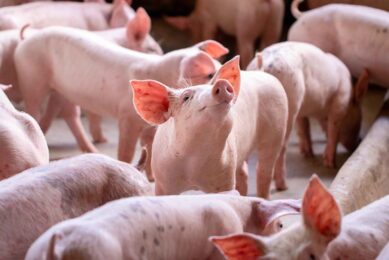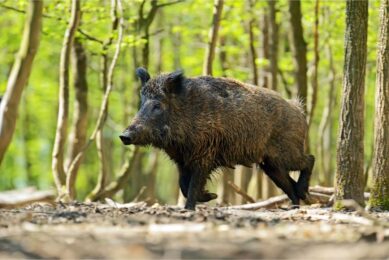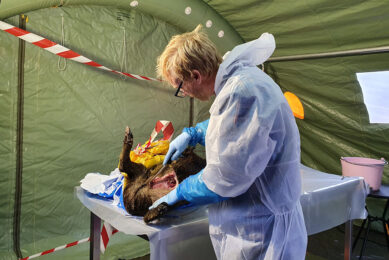By Gordon Allan1, Steve Krakowka2 and John Ellis3,
1 Veterinary Sciences Division, Department of Agriculture and Rural Development for Northern Ireland,
2 Veterinary Biosciences, The Ohio State University College of Veterinary Medicine, USA,
3 Medicine University of Saskatchewan, Canada
The global explosion of post-weaning multisystemic wasting syndrome (PMWS)/ porcine circovirus disease (PCVD) in the last two to three years has raised many questions regarding the source and nature of the disease epidemic. Retrospective testing of pig sera for antibodies for porcine circovirus type 2 (PCV2) and retrospective examination of tissue samples from pigs has shown that antibodies to a PCV2 virus have been present in the pig population since 1969, at least1,2, and sporadic cases of classical PMWS/PCVD have now been identified in Spain and England from 1986 onwards3. These findings, combined with results of experimental infections, provide strong evidence that PCV2 is not a ‘new’ virus and PMWS/PCVD is not a ‘new’ disease. However, in contrast, field observations and epidemiological studies in the UK strongly indicate that the spread of PMWS/PCVD since 1999 has been consistent with the introduction of a ‘new’ infectious agent into a naïve population4.
New terminology necessary PMWS is now recognised as a global epidemic disease that causes significant economic losses to pig farmers throughout the world. PCV2, a ‘new’ circovirus of pigs, is regarded as being the causal agent of PMWS9,10,11,12. However, in addition to PMWS, strong evidence from field and experimental studies has also linked PCV2 infection to reproductive problems in pigs and early (post-weaning) and late (porcine respiratory disease complex) respiratory disease13,14. Serious consideration should now be given to replacing the terminology PMWS with porcine circovirus disease (PCVD). |
Not a new virus
Recent studies within our group have added further support to the proposition that the PCV2 virus associated with PMWS/PCVD in the UK and elsewhere is not a new virus. In these studies a PCV2 virus was isolated from tissue samples taken from a SPF pig in Sweden in 1993, which had no clinical signs or histological lesions consistent with PMWS/PCVD.
To date, no cases of PMWS/PCVD have been observed in Sweden. Using this Swedish PCV2 isolate we were able to experimentally reproduce clinical PMWS/PCVD in CD pigs following inoculation by an oral/ nasal route at 3-4 days of age. Indeed, all of the inoculates in this experiment given PCV2 (n = 13) either developed severe clinical disease (n = 6) or had severe histological lesions at termination (n = 7). All histological lesions were associated with an abundance of PCV2 antigen. Therefore, experimental infection of pigs with a PCV2 isolate from a non-PMWS/PCVD pig sacrificed in 1993 from a country that has, to date, never recorded a case of PMWS/PCVD resulted in clinical disease and histological lesions consistent with PMWS/PCVD. These clinical signs and lesions were indistinguishable from those obtained following experimental infections with PCV2 isolates from pigs with PMWS/ PCVD. Although these results are limited to a single PCV2 virus isolate and need to be expanded to include experimental infections of pigs with PCV2 isolates from other non-diseased animals from other countries, they do raise some interesting questions and possible ‘nightmare’ scenarios for the global pig industry.
Possible ‘nightmare’ scenario
We know from serological surveys that PCV2 infections are common in countries around the world, including Sweden, and that the vast majority of these infections are subclinical. However, we also know that a PCV2 virus from a sub-clinical infection in Sweden has the potential to be causal of PMWS/PCVD. Does this mean that the potential exists for all pigs exposed to PCV2 to develop PMWS/PCVD? If so, what predisposing factors exist that potentiate a normal sub-clinical infection with PCV2 (as in Sweden) to a clinical scenario resulting in PMWS/PCVD?
What we know
To date, research into PCV2 and PMWS/PCVD has provided a number of answers to specific questions. However, the results generated have also raised more questions that require urgent attention.
•We now know that PMWS/PCVD is not a ‘new’ disease of the late 1990s and sporadic cases have been retrospectively identified from at least 1986.
• In addition we know that PCV2 is not a new virus of the late 1990s as PCV2 antibodies have been demonstrated in pig serum from at least 1969 and isolates of PCV2 have been recovered from pigs sacrificed in the early 1990s, before the appearance of epidemic PMWS/ PCVD.
• Importantly, we now know that a PCV2 isolate from a sub-clinical infection in 1993 has the potential to cause full blown PMWS/PCVD that is clinically and histologically identical to the disease produced following experimental infection of pigs with a PCV2 isolates from recent cases of PMWS/PCVD.
What we think we know
• Fortunately, we now think we know that good transfer of maternal antibody PCV2 to piglets protects against the development of PMWS/PCVD5. In pigs that do not receive adequate passive transfer of antibody, infection with PCV2 and modulation of the piglets immune system (immunostimulation) are the pivotal events in triggering the disease process, leading to PMWS/PCVD6.
What we don’t know!
• Unfortunately, we still do not know the exact mechanism(s) of immunomodulation that lead to PCV2 potentiation and disease. Indeed, to date, we still do not know the primary site of replication of PCV2 in pigs or whether the abundance of antigen detected in macrophages and dendritic cells in diseased animals represents phagocytosed antigen only, or replicating virus. Recent results of in vitro studies have indicated that PCV2 does not replicate in these cell types nor, importantly, is it degraded7.
• Most importantly, we still do not know why or how sporadic PMWS/PCVD suddenly exploded into a global disease epidemic in the mid to late 1990s. Field evidence suggests a ‘new’ infectious agent, but, to date, laboratory studies do not support this. If a new infectious agent did not emerge to cause PMWS/PCVD, then, logically, something related to global pig production changed in some way to facilitate a disease outbreak. To date, studies have indicated that changes in husbandry practises and early vaccination strategies can act as ‘triggers’ for PMWS/PCVD, however, further studies are required in these areas.
Genetic influence?
The one area of pig production that has not been addressed in detail as a potential problem in relation to PMWS/PCVD is genetics. During the mid 1990s pig breeding companies competed for higher conformation carcase production and ‘natural’ selection was used to breed for leaner traits in sire lines and prolificacy in dam lines. In addition, the concept of breeding pigs for resistance to specific diseases was accelerated. In a recent review article on this topic8 the authors state “disease of the host is not the evolutionary goal of the pathogen. Sub-clinical infections are common, they are the rule, diseases are the exception.” This would appear to have been the situation with PMWS/PCVD until recently. In the same article the authors go on to make the following important observation, “the interplay between microbes and host should not necessarily be seen as an ongoing battle but a co-evolution of species”. Is it possible that accelerated breeding by ‘natural selection’ for leaner traits, increased prolificacy and/or disease resistance has resulted in an unforeseen modulation of the PCV2-host co-evolution? Is it possible that susceptibility to develop PMWS/PCVD is related to linkage disequilibrium of certain production traits?
Genetic traits are linked in complex ways and over-selecting animals for physical traits can often cause changes in other parameters, including immune functions and responses to stress. Certainly there are increasing anecdotal reports from pig farmers and veterinarians of a breed/line predisposition to PMWS/PCVD. It is of utmost importance that proper scientific studies are immediately initiated in this area and the results put into the public domain as soon as possible.
Debate over role of PCV2 and PRRSV in PMWS It has been proposed that “based on current experimental findings, PCV2 seems to fill the role of a secondary opportunist rather than a primary agent”15. It has also been suggested that PRRSV is an important primary agent in the development of fullblown PMWS. A careful examination of the scientific literature published negates both of these alternative hypotheses. Firstly, there are numerous reports of outbreaks of severe PMWS/PCVD (up to 40% losses) on PRRSV-negative farms and, indeed the index case of PMWS reported in 1997 was recognised on such a farm16. Thus, severe, clinical PMWS/PCVD with significant mortality occurs on PRRSVnegative farms. Secondly, scientific literature of experimental infections of gnotobiotic, colostrum-deprived (CD) and colostrumfed (CF) piglets with PCV2 alone, or in conjunction with other infectious agents, have clearly demonstrated that clinical PMWS/PCVD can be reproduced without PRRSV infection17,18,19,20,21. Indeed, the published results of Harms et al., (2001) clearly demonstrate that inoculation of CD pigs with a PCV2 isolate recovered from a outbreak of, so called, acute or atypical PRRS22 resulted in clinical disease and death in 26% of the inoculates. In contrast, inoculation of CD pigs with the proposed ‘highly virulent’ strain of PRRSV recovered from the same acute PRRS case resulted in a transient respiratory disease of no mortality with low to moderate numbers of PRRSV antigen-positive cells in lung lesions. In addition, the results reported by Krakowka et al., (2001) clearly show that PCV2 is the only infectious agent necessary for development of PMWS/PCVD in a gnotobiotic pig model. In the face of these and other reported results of experimental infections, it is difficult to maintain the arguments that “PCV2 is a secondary opportunist, rather than a primary agent” and that PRRSV is an important primary agent in Development of clinical PMWS. Indeed, the experimental evidence for the role of PCV2 as a primary pathogen of young pigs is substantially stronger than the experimental evidence presented to date for PRRSV in that role. |











